My First Half Marathon in Numbers

On 28th September 2025, I joined 4,419 runners at the start line of the Ealing Half Marathon. It was so overwhelming. But I knew each person running along with me had a story. There were elite runners chasing personal bests, seasoned runners who make it look effortless, first-timers like me taking on our very first 13.1 miles and even runners in their 60s and 70s, who were so inspiring. We were all united by one simple goal - to cross that finish line.
As I made my way towards the long start line, I couldn’t stop thinking about one thing - which pacer should I stand close to?
(For my non-runner friends - pacers are runners who carry a flag or balloon on their back showing the target finish time, so others can follow their pace)

I kept replaying all my practice runs in my head. To the world, I said, “I just want to finish under 2 hours 30 minutes.”
But my real goal for me was 2 hours 15 minutes.
Fueled by race-day adrenaline (and my classic over-ambitious self 😂), I decided to line up with the 2:10 pacer.
For the first 3 km, I felt AMAZING, like I could run forever. The 2:10 pace felt surprisingly comfortable. But around the 7 km mark, that high started to fade. I started to experience an excruciating pain in my left arm, something I’d never experienced before while running. I’m still not sure why that happened. I looked at the data later, and feels like it was my heart rate that might have triggered that pain? The heart rate shot up to 184–187 bpm and stayed high for several minutes after the sneaky little hill. But surely runners experience a much higher heart rate while running. I researched later, if this is something I need to worry about but looks like it could be a posture/arm-swing/upper-body fatigue issue, especially when you’re pushing for a pacer or climbing even a small hill that makes your body strain.

But that’s when I had to let go of the pacer. It felt like watching a goal slip away in slow motion and the doubts started to creep in. But I was constantly reminding myself -
I have run 18 km in training. I knew my body could handle it. I just needed to run my own race, at my own pace.
I will deviate here for a second and let my fellow beginner runners in on a secret.
YOU GOT TO OWN YOUR RACE.
There will always be runners who are faster, smoother, and barely breaking a sweat at 10 km. And that’s okay.
Because your race isn’t about them - it’s about YOU.
So I shed the pressure of finishing in a certain time. From that point on, it wasn’t about the clock, it was about the journey. Running is as much about mindset and heart as it is about numbers - pace, splits, elevation, and recovery. And being a data person, I couldn’t resist analysing how I actually performed that day compared to other runners.
So I downloaded the full Ealing Half Marathon results - 4,419 runners, each with their category, gender, and finish time. And here’s what I found.
The big picture - "Who ran the Ealing Half Marathon?"
The data tells us that out of all the people who ran the half marathon,
65% were males and 35% were females.
Have we spotted another field with a gender gap? 👀
I wonder if this trend holds true across other races too.

In the female category, most runners (about 48%) were younger, between 18 to 35 years. But a nearly equal 43% were middle-aged (between 35 to 55). Very impressive, right? It’s no secret how tough it can be for women to carve out time for themselves between careers, families, and a hundred invisible responsibilities. Seeing so many women in their 30s, 40s, and 50s show up on race day was genuinely inspiring. It’s a reminder that prioritising health isn’t about having time, it’s about making time.
For men, the numbers are more skewed towards the younger side. Also, did you notice how the age categories are different for men and women? I didn’t know that before analysing this data. It turns out that race classifications in the UK define veteran categories differently. That’s because the performance and endurance curve tends to shift slightly earlier for women, so the age brackets are adjusted to keep competition fair across genders.
Zooming in - “My category: FSen”
Okay, so let’s zoom in on the stats within my category.
Out of 754 females, 7 didn’t finish, leaving 747 runners in total.
I ranked 531st in my category, finishing in 2 hours 20 minutes and 38 seconds.
The chart below compares me with other female runners in the same group.

I finished faster than 29% of the runners in my category, meaning 71% of women ran faster than me. Oh dear, I probably felt better before doing this analysis 😂.
But honestly, this is what makes data beautiful - it gives perspective.
Knowing where you stand should not be discouraging, it should be informing and motivating to perform better next time.
Every Second Counts
When I grouped the finish times of runners in my category (FSen) into 5-minute intervals, the chart formed something close to a bell curve, but interestingly, with two peaks.

It’s fascinating to see how tightly packed the runners are around certain time windows. The average finish time in my category was 2 hours 11 minutes, and the median was just a bit faster at 2 hours 9 minutes, suggesting most runners finished around a similar window, with a few outliers taking a bit longer. This chart tells us how a few minutes here or there can shift your ranking by dozens of spots.
To put that into perspective, the top three female runners in my category all finished within the same 5-minute window, separated by just seconds:
🥇Rank 1 — 1:20:06
🥈 Rank 2 — 1:20:43
🥉Rank 3 — 1:23:02
That’s less than three minutes apart between first and third place! It’s incredible how much dedication, training, and precision it takes to compete at that level.
For me, the goal was simpler, to finish strong in my first half marathon. At the 10 km mark, my chip time was 1:06:42.3. I wished I had crossed it closer to 1 hour, since I’d managed to do that several times during my practice runs. By 18 km, I was at exactly 2 hours, identical to my longest training run. That gave me a strange sense of déjà vu, as if my body knew the rhythm of that distance. But those last 3 km truly tested me. My pace dropped between 7:33 and 8:02 min/km, and every step felt heavier than the one before. But then came the final mile and those familiar, friendly faces. Their cheers brought back a surge of energy I didn’t know I had left. I pushed through, and before I knew it, I was crossing the finish line.
The satisfaction was unreal. I finally had my first finisher’s medal hanging around my neck and a story I’ll always proudly tell.
Closing - “What the data doesn’t show”
Because the numbers can’t capture the real experience. The joy of crossing that line, the cheers from the crowd, the high-fives from strangers, or the moment I spotted my friends, who had travelled three hours just to be there on my special day. And my partner running beside me in that last stretch, helping me cross the line when I needed it most. Honestly made me feel so blessed and loved.
And lastly, I think it’s the journey to those 21 km that matters even more than the race itself. The effort you put in, the discipline you build, and all the positive changes running brings to your life.

You can compare your stats to others all you want and it’s a great way to push yourself but never forget the most important comparison: you vs. you. Because that’s the story every runner truly runs.
Maybe it’s the runner’s high talking, but I think I always want to be half-marathon ready. 🩵

